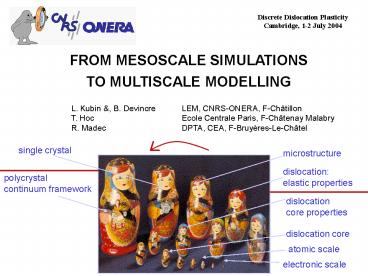Pr - PowerPoint PPT Presentation
Title: Pr
1
(No Transcript)
2
OUTLINE
- 1 DDD simulations
- elastic properties
- 2 DDD simulations
- connection with atomic scale
- 3 Typical problems at mesoscale
- 4 Coupling with the continuum
- Full DDD
- Constitutive modelling
- Continuum theory of dislocations ?
3
(2-D, 2.5-D) 3-D SIMULATIONS
interactions P-K force line tension junctions
dislocation flux (basic DDD)
stress equilibrium (full DDD)
mobility laws cross-slip ............
4
Elastic properties of dislocations
can be very complicated not an issue for
DDDs down to a few Burgers vectors
dislocations vs. small loops, other dislocations,
obstacles (planar glide)
5
DISLOCATIONS AND DEFECT CLUSTERS
(radiation damage fatigue)
6
JUNCTIONS -gt FOREST HARDENING
The Lomer-Cottrell lock (Saada 1960 , Schoeck
Frydman 1972)
R. Madec et al. 2001
D. Rodney R. PHillips, 2000 (MS)
same critical stresses (t ? mb/l)
junctions elastic problem gt no free parameter
7
STRENGTH OF THE FOREST
Up to large strains, insensitive to SFE,
Cross-slip, rotations, long range stresses,
GNDs, patterning
8
Local rules
9
LOCAL RULES
series connection with atomic scale needs models
rate equations, elastic models (Escaig, Schoeck
et al.,..) gt saddle points, equilibrium (MS
simulations) fast events (MD simulations)
- Dislocation theory is not finished ....
- FCCs cross-slip (Cu) scaling laws
- BCCs ab initio core structure (C. Woodward)
- kink-pair mechanism (J. Moriarty)
- solute atoms and screw dislocation cores (BCCs,
Ti) - dislocation generation in defect-free volumes
- - homogeneous (S. Yip)
- - heterogeneous
- (crack tips, surfaces, nanoindentation,
- grain boundaries, interphases, epitaxial layers
..)
10
MOBILITY / MICROSTRUCTURE
fast moving dislocations (Zbib et al.), climb
velocities ?
11
CROSS-SLIP (FCCs) MESOSCOPIC VIEW
multiplication/annihilation dynamic
recovery pattern formation precipitate
bypassing textures
b
12
MESOSCOPIC LOCAL RULES
..... mesoscale simulations are weak in chemistry
13
- Typical issues for basic DDDs
- single crystal
- hardening patterning
- interactions between slip systems
- composition of mechanisms
- (ex Peierls stress forest hardening)
14
MASS SIMULATIONS
Cu, 100 stress axis
.
Not necessarily the best way for understanding
hardening
15
CELLS and CROSS-SLIP
"similitude principle" ? structure of internal
stress
(111) foil t 3 mm
10 mm
(110) foil t 3 mm
von Mises stress
16
- Interactions between slip systems
17
INTERACTION COEFFICIENTS (FCCs)
tc ambvr gt
(Franciosi et al., 1980)
12x12 144 gt 6
junctions a3 Lomer a2 glissile a1ortho
Hirth
a0 self a1copla coplanar
the collinear interaction(b SP, b CSP)
acoli measurement by model simulations acoli
15 a3
18
THE COLLINEAR INTERACTION
P1 ? P2 same b
exhausts the mobile dislocations leaves small
stable debris
19
COLLINEAR INTERACTIONS
20
STRESS-STRAIN CURVES IN MULTISLIP
Cu, 300 K, 100, 8 active slip systems DD
simulation critical stresses reconstructed
from
B 4 slip systems are de-activated
A the cross-slip systems of B remain
active A', B' same but without collinear
interaction
21
Coupling with the continuum full DDD
22
NANO-GRAINS
s
d (nm-1/2)
Atomistic simulations d 30-50 nm but still no
Hall-Petch law ! DDD simulations ?
23
HALL-PETCH
scaling k ? (atomic ? meso ?) dislocation-grain
boundary (local rule at mesoscale) continuum
modelling ?
24
3D MMC COMPOSITE(full DDD)
There are size effects in s001and density/stress
gradients but how can we compose mechanisms
forest hardening (basic DDD) load
transfer (FE) size effects (full DDD) ?
25
CONSTITUTIVE MODELLING
Basic DDD dislocation-based models
crystal plasticity codes
Basic DDD simulations are used to feed
(tensorial) dislocation-based constitutive models
Avoids/limits parameter fitting Many possible
applications up to large strains atomic meso
continuum
26
HARDENING MATRIX
This constitutive formulation is parameter-free
for copper crystals It is inserted into a crystal
plasticity FE code (boundary conditions ..)
27
Cu crystals
28
STAGE I - STAGE II
Prediction of slip systems
No information needed about dislocation
mstructures as long as there is no change in
deformation path Next step Bauschinger test
29
STRAIN LOCALIZATIONS JERKY FLOW
FE code for polycrystals (A. Beaudoin) no
gradient term, incompatibity stresses Constitutiv
e formulation
s qe ? F( )
Al-Mg alloy 2 10-4 s-1 Type B
All types of bands and dynamic behaviour
S. Kok et al. Acta Mater. 51 (2003) 3651
30
CONTINUUM THEORY OF DISLOCATIONS ?
31
SUMMARY
- All DDDs
- local rules (need atomistic input)
- small strains
Basic DDD tool for modelling/understanding
interactions, microstructures, strain
hardening more powerful, modelling connection
with crystal plasticity codes
Fulll DDD applications ...potentially,almo
st everything small strains few achievements
till now (in 3-D) can we draw models from it ?































